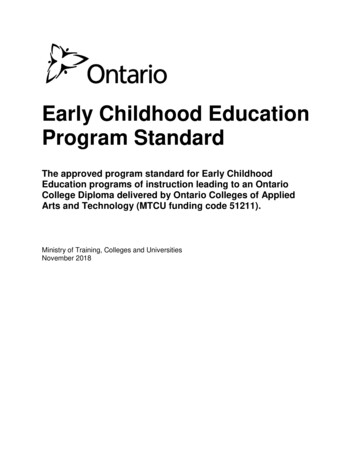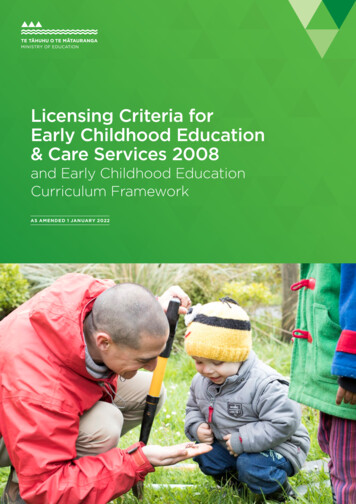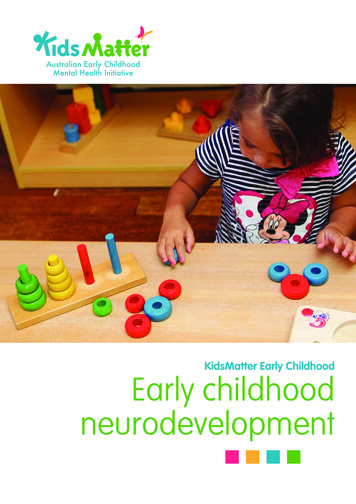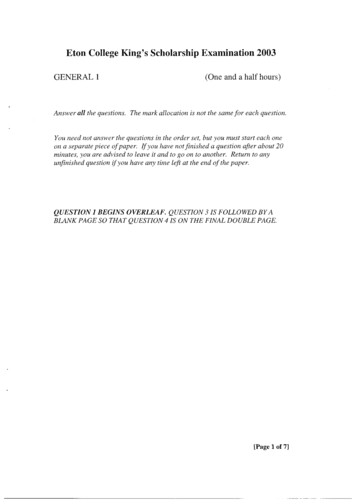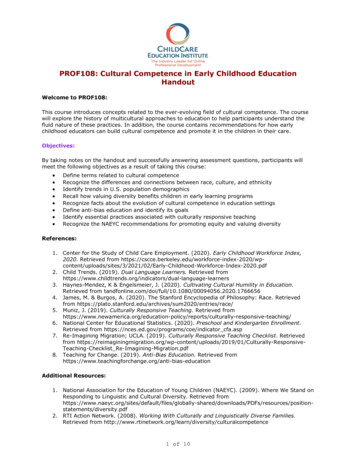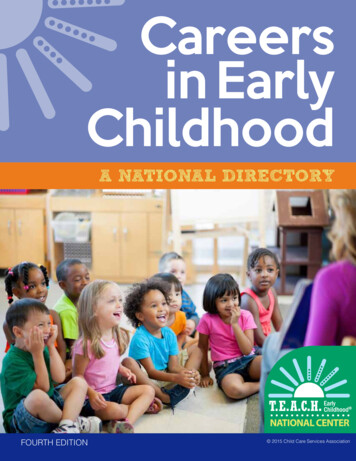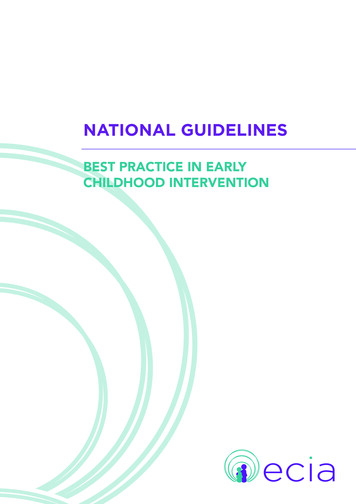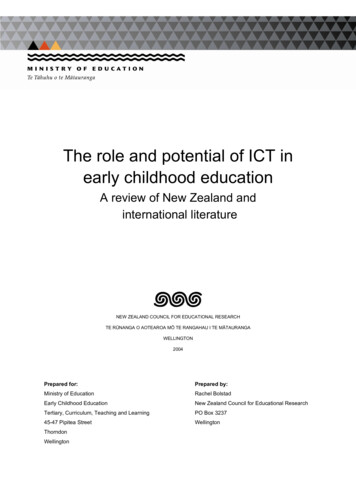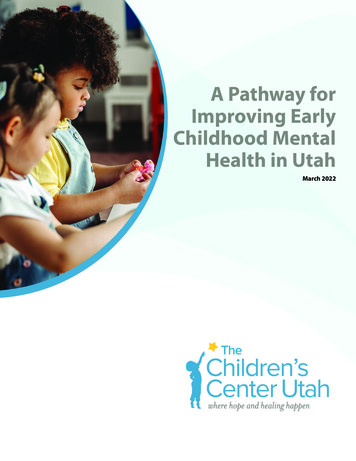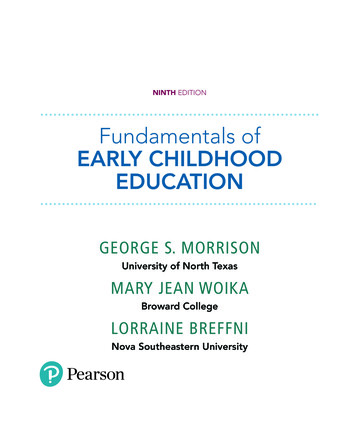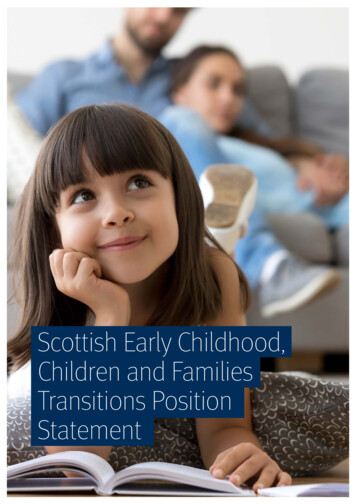
Transcription
Scottish Early Childhood,Children and FamiliesTransitions PositionStatement
2Setting the Contextn today’s world children and families experience moretransitions than ever before: transitions are truly away of life. Early childhood and family transitions influencechildren’s day-to-day experiences and may have an impactin the longer term: for young children the first transitionsmay be into a care and early learning setting beyond thefamily and later into early primary school.Transitions research and practice suggests that a positivestart to school supports children in making importantrelationships with their educators and peers, in experiencinga sense of wellbeing and belonging when they are met by abalance between familiarity and the new, and in developingpositive expectations (Educational Transitions and Change(ETC) Research Group, 2011).Family experience is affected by many factors, includingrelationships, health and well-being, housing andcommunity, income and the services available. Familiesseek and are the main providers of continuity in theirchildren’s lives: supporting them to navigate change.As their children look forward to their first out-of-homeexperiences, the family task of providing continuity is madeeasier by responsive practitioners and early childhood andschool settings. This Scottish Early Childhood, Children andFamilies Transitions Position Statement, developed throughthe Transitions as a Tool for Change Seminars Series andConferences, and in collaboration with families, seeks todraw out important aspects of transitions in early childhoodand to offer a set of principles and actions that stand tomake a difference here in Scotland.It is recognised in Scottish Policy that experiences in theearly years of life affect the journeys that children makethrough childhood: in the family, in early learning andchildcare, in school and in the community. In 2017 ScottishGovernment published its Blueprint for 2020 heralding theexpansion of early learning and childcare. This importantpolicy document lays the foundation for new approachesand a new significance being placed on children andfamilies in the early years, and upon the practitionerswho work with them, building on the foundations laid in2008 when The Early Years Framework was published byScottish Government. Since that time we have seen theestablishment of Getting it Right for Every Child, the revisionof the Birth to Three Guidance (2005) as Pre-Birth to Three:Positive Outcomes for Scotland’s Children and Families,and the rolling out of a Curriculum for Excellence: all relatedto a commitment to do the best for all children towardscreating an equitable Scotland in which all children maygrow up being able to realise their potential. This emphasison the best possible start and the desire for equity brings aparticular focus on transitions in early childhood, not onlyin Scotland, but worldwide. The OECD published StartingStrong V – Transitions from Early Childhood Education andCare to Primary Education in June 2017, further emphasisingthe importance of attending to transitions by bridging andnarrowing gaps between sectors.IThe early years, starting from before birth, offer a periodof significant learning and development. Developmentis normally a continuous process, building on what hasgone before. Play, the natural activity of children, is alsocontinuous. Of course changes happen in the nature ofthe developmental journey, in learning and in play, andnone of these is exactly the same for all children. Our earlylearning and school systems on the other hand are notcontinuous: they face children and their families as wellas the professionals who work with them, with times oftransition and potentially of interruption in learning anddevelopment. Traditionally systems are organised intoseparate sectors: early childhood, primary school educationand the secondary years of schooling. Policy and guidancenevertheless promote continuity.In Scotland The Blueprint for 2020, Quality ActionPlan (Scottish Government, 2017b) includes twelveessential characteristics of quality as defined by theQuality Action Plan stakeholder group: these include
Scottish Early Childhood,Children and FamiliesTransitions Position Statement3In today’s world children and familiesexperience more transitions than ever before:transitions are truly a way of life.‘transitions that are well-managed’ and outlines waysin which strong pedagogical leadership; supportingparents; professionals working collaboratively; CPLopportunities; current guidance such as Building theAmbition (Scottish Government, 2014), Pre-birth to Three(Scottish Government, 2010) and Curriculum for ExcellenceEarly Level (Scottish Government, 2007); supportingprogression, and support services at key points oftransition may each contribute to more positive transitionsfor children and their families.Scotland was one of five countries that took part in the‘Pedagogies of Educational Transitions’ Project, alongsideresearchers, policy makers and practitioners fromAustralia, Iceland, New Zealand and Sweden. Staff fromeach of five universities: one in each country, collaboratedin a series of work packages held in each of the countries.The Scottish Work Package was called Transitions as Toolsfor Change and took place in Glasgow in September 2015.The work generated from this project attracted ScottishGovernment Workforce Development Funding to buildon the learning from the wider-participation sessions inSeptember 2015, by offering a series of working meetings,presentations and a conference continuing through 2016.Following our original Seminar Series and SucceedingAgainst the Odds Conference we have been working onthemes of participation, opportunities, expectations,entitlements, aspirations and contribution in relation toearly childhood experience before and after school start.Family engagement, learning journeys and leadershiparound transitions each make a contribution to supportingchildren to cope with change and future transitions.Five Briefing Papers were produced following theSeminar Series, and it is from these, and through the richknowledge exchange during the Series, that this ScottishEarly Childhood, Children and Families Transitions PositionStatement has grown.AimsThis Scottish Early Childhood, Children and FamiliesTransitions Position Statement is informed by a sharedunderstanding of the importance of transitions and theneed to address the impact of transitions in children’slives. We share the idea that a shared agenda for actionwill afford the best possible start in new settings andtherefore aims To look at the opportunities, expectations andaspirations of early educators, children and familiesat times of transitionTo understand children’s learning journeys,attainment and learning outcomes and thecontribution of positive transitionsTo consider children’s entitlements at times oftransitionTo interrogate the extent to which early yearstransitions and transitions to school provide forthe participation of child, family and professionaltogetherTo reflect on beliefs and practices around transitions,the contributions children and families can make andto ensure transitions leadership in the system
4The SixPrinciplesIn order to ensure that families, children andproviders in the early years and into schoolshare understandings of the importance entitlementsparticipationcontributionThis statement elaborates the six principlesand aims that they are all valued and respectedthrough mutual knowledge sharing.1AspirationsAt times of transition, families and communities want theirchild’s prior learning to be recognised and valued withininspiring, challenging and supportive environments. Withinan aspirational community, the importance of continuity ofexperience is recognised, in balance with positive change.Aspirations are underpinned by recognition that children arecreative, capable and competent. There is a need therefore toraise the aspirations of practitioners, parents, and children foran holistic approach to transitions which embraces these sixinter-connected principles. Families hope their children will be happy and make agood start in any new setting, will be liked, respected andencouraged in their development and learning, and willbe listened to.Children seek companionship and connections withothers, thriving when their learning, friendships andvoices are valued and met warmly, responsively andpositively.Educators1 aspire to support children well, listen to theircontributions and extend their learning and development.In realising a holistic transition for the child and their familythis statement promotes and encourages the existenceof effective collaborative partnership working across andwithin the varied ELC landscape and into the early years ofschool. Such partnerships acknowledge that continuity forchildren and families is achieved through strong, mutualunderstandings. Social, cultural and emotional resilienceis key to sustaining and extending reciprocal trustingrelationships and friendships. These shared understandingswill include an understanding of, and put a premiumupon, wellbeing, curricular continuity, positive educationaloutcomes and play as pedagogy.To ensure such aspirational outcomes for and with children,families and communities, seeing transitions as a tool forchange means taking realistic, achievable and innovativesteps towards meeting child, family, community and educatoraspirations.1Educators is used to signify all practitioners and teachers with a responsibility for the care and education of young children in early learning and care (ELC)and early primary school settings.
Scottish Early Childhood,Children and FamiliesTransitions Position Statement2Expectations5For children and families, moving into their early learning and childcaresetting, and later on to primary school, should be a dynamic process, and atime of both progressive continuity and positive change.These early transitions, like other transitions, are often regarded as animportant milestone in our lives. We find that transitions often featurestrongly, and come to mind most readily, when we try to recall our earliestchildhood memories. We know that a transition should not be regarded asa single or isolated event, but rather recognised as an ongoing process.When you factor in the important role played by our expectations, which areformed over an extensive period of time in the lead up to transitions, then itis important that professionals don’t leave transitions to chance, but workin partnership with children, families and communities in a planned andproactive way.Effective transitions into primary school should therefore take account ofthe extended time over which children’s and families’ expectations start toform, and up to the time when they feel settled, secure and have developed asense of belonging and wellbeing within the new situation. If parents expecttransitions to be positive, and they feel confident and enthusiastic about whatlies ahead, then children are much more likely to feel relaxed and happy too.Children’s expectations are formed largely by what their families say and howthey act. This is why transitions cannot be understood or treated solely as achildren’s matter, but rather as a family matter.If transition-related actions recognise the important needs and interests ofthe adults in children’s lives as a natural and intrinsic part of high qualitytransitions, then this in itself will enrich children’s experiences.If children’s expectations are formed and shaped predominantly by theirfamilies, then where do parental expectations come from, and what informsand shapes them?For the most part, parental expectations are built from parents’ own personaland previous experiences, as well as what they learn and hear from family andfriends. In some cases, these experiences may not have been positive, and sothe lead-up time to and through transitions can therefore be looked upon andseized as a valuable opportunity to work together with children and familiesto help shape optimistic and confident expectations around transitions.Young children naturally expect professionals to care about, understand,value and respect them and their family life, language and culture. If theseexpectations aren’t realised, instead of developing a sense of belongingand wellbeing within the new situation, there is a risk that children will feelisolated, insecure or excluded.Changing the narrative from transitions being a scary experience to oneof positive self-expectancy and joyful anticipation about new and excitingopportunities, is paramount.
63OpportunitiesThinking of transitions as an ongoing aspect of early childhood and familyexperience allows us to view transitions as a tool for change which createsmany opportunities.While continuity is important so is change. Well managed transitions providethe opportunity for continuity while recognising and celebrating the changethat is happening. These transitions provide the opportunity for children andfamilies to develop resilience; to recognise and celebrate progress and lookforward to new challenges ahead.There are many opportunities to embed continuity in transitions. From familiarroutines the first time the child is cared for by someone outside of theirown home or family circle, to continuity of relationships, to consideration ofcontinuity and progression within the curriculum.Experienced early level professionals know that positive transitions happenwhen the process is perceived as a collective responsibility where the sharedaim is to ensure that children settle, thrive and develop a sense of wellbeingand belonging within the new setting.Early level staff will create and embrace opportunities to have ongoing andopen conversations with children and parents on either side of the move, sothat they hear, understand and can support and address any lurking fears oranxieties that children and/or parents are harbouring.The small, mid-scale and large-scale systems that underpin transitions allprovide the opportunities to improve children and families’ experiences.Connected systems which are responsive to community and family needssupport continuity, policy delivery and improved outcomes. They can provideuniversal opportunity with the ability to progressively target need.Transition provides opportunities for professional dialogue across andbetween settings. Practitioners have the opportunity to share theirprofessional beliefs and values and pedagogical practice to develop sharedapproaches that support progression in learning and developmentallyappropriate practice.Transitions often provide the opportunity to develop and deepen relationshipswith the whole family. These opportunities can be the stimulus for families totake up opportunities for family learning or for practitioners to offer supportfor parental engagement in learning and support for the home learningenvironment. These opportunities can also lead to training and support forparents, employment, and the transformation of family life.The opportunities for developing relationships can lead to families developingsocial capital and supporting one another. This in turn can lead to moreempowered systems with greater community involvement and the coconstruction of services for families.
Scottish Early Childhood,Children and FamiliesTransitions Position Statement4Entitlements7Children are entitled to feel safe, secure and connected in environments thatintegrate attention to development and learning in an holistic way, when theychange settings. Transitions may occur within the day, day-to-day, acrosstime and between different providers, for example from home to nursery,from home to childminders, from home and childminders to the early years ofschool from ELC to school.Children are active in their own transitions and are entitled to continuity ofrelationships, play, learning, curriculum, resources and environments whichare responsive to their needs and rights. They need to have their previousexperience and contribution recognised in any new setting, building on whathas gone before.Families and their children are entitled to quality, flexibility, affordability andaccessibility of services. They are entitled to be listened to and respected ascollaborators in their children’s ELC and early school experiences, learningand well-being.Every child and family is entitled to recognition of their own culture, identity,language and histories and to these being met by high quality, equitableprovision in our ELC and school settings. Knowing that receiving settings willalways make time to see and get to know each child and their family as a unit,is fair and just.These entitlements sit comfortably with, and challenge thinking about currentwork in Scotland towards progressing the human rights of all children inScotland (Scottish Government, 2018).
85ParticipationThis statement recognises the importance of starting early. It acknowledges theneed to equip parents and families with the skills and confidence to participateappropriately throughout the transitions process. To achieve the best possibleoutcomes for children, parents, families and communities then family andcommunity engagement at times of transition should be underpinned byresponsive, respectful relationships. Participation is strengthened when allconcerned with the child begin by capitalising on the strengths and assetsof the wider community. Working in this way will provide opportunities for allconcerned to become resilient participants in the inevitable horizontal andvertical transitions that children and families encounter in life.Making space for open conversation with children and families over anextended period of time, prior to, and following the transition, can helpenormously to reduce apprehension and increase familiarisation so thatpositive expectations develop through a participative process, and confidencelevels grow accordingly. Issues around for example toileting, playground, feweradults, acceptance, bullying, friendships and learning are some of the areasquoted by parents when they are asked about their anxieties around their childstarting school.In Scotland, we want children and families to participate in a shared andsupported way to ensure positive expectations leading to positive transitionexperiences. Having positive self-expectancy helps children and parents tocreate their own self-fulfilling prophecy for affable relationships, friendships,fun, learning and a sense of comfortableness and achievement.Genuine participation means families will be welcomed with unconditionalacceptance, and respected for knowing their own child best. It also means thatprofessionals right across the early level will work with every family to createhelpful bridges from the familiar into the unfamiliar, as the norm.Children and families will always approach transitions with a range of differingexpectations and feelings about what the up and coming new experience willbring. Fortunately there is much that professionals can do to ensure that thoseexpectations are formed on a basis of honesty with trusted professionals, whosee every child as knowledgeable, curious, capable and competent, and seekto be involved with all families.
Scottish Early Childhood,Children and FamiliesTransitions Position Statement6Contributions9As we know, confidence in participation and participatory practice dependson collaborative working within and across communities, supported by aninclusive culture where contributions are explicitly valued and nurtured.Having positive self-expectancy that professionals will seek, recognise,appreciate, celebrate and build on children’s prior, and existing skills,achievements and knowledge, should be part and parcel of transitions for allchildren and families throughout their journey. Fostering family contributionsthrough knowledge sharing in a welcoming ethos lays a foundation for familiesthat their contribution is valued by our systems.A sense of belonging is critical to each and every person as they move fromthe familiar to the new. For young children this sense of belonging is fosteredby feelings of competence and of making a contribution. This means findingthemselves with others who recognise and draw on their funds of knowledge,people who work from a strengths based approach and who take time to getto know newly arrived children and appreciate their dispositions. Bringingideas, stories, experiences and favourite memories and being able to makechoices over what to do and to share with others foster feelings of pride andcontribution.
10RecommendationsThe Scottish Children and Families Transitions PositionStatement has been developed both as a call to action,and as guidance for all those who place an importanceon early childhood experiences, are committed tothe best interests of the child, and know that meansworking together with both children and their families toensure the best of experiences, positive relationships,positive continuity, learning, play and wellbeing. Thisincludes educators, researchers, policy makers, families,associated professionals, educational systems and localand national government embracing the significance oftransitions for children’s lives:1. Use the six principles in shaping policy and practices2. Focus on children’s and families’ strengths,creativity, capability and competence3. Recognition that attention given to transitions is partof ensuring quality in ELC and early Primary School4. Confirm child, family and educator participation intransition approaches through mutual consultationand support5. Include all families in transitions processes,providing appropriate support to ensure equity6. Leadership and support for educators involved intransitions process, with a particular focus on play,pedagogy, curriculum and reflection7. Recognition that the transitions that are part of oursystem can be opportunities and tools for change8. Continued commitment to the entitlements ofchildren, families and educators during the processof transitionsAcknowledgementsThe development of the Scottish Children and FamiliesPosition Transitions Position Statement draws four of itsprinciples from the Transition to school: Position statement(2011) by the Educational Transitions and Change (ETC)Research Group. In 2010 this international group workedtogether at Charles Sturt University in Albury-Wodonga,New South Wales, Australia. We owe our inspiration todevelop a children and families statement for Scotlandto the experiences of participating in, and subsequentpublication emanating from this group under the skilfulleadership of Professors Sue Dockett and Bob Perry.We also acknowledge all the seminar and conferenceparticipants in the original series, the members of theMarie-Curie IRSES Pedagogies of Educational TransitionsGroup, our funders: the Scottish Government WorkforceDevelopment Group, and the in-kind support of theUniversity of Strathclyde, Glasgow and North LanarkshireCouncils, the Scottish Childminding Association, EarlyYears Scotland and Education Scotland.Thank you all for making this possible.
Scottish Early Childhood,Children and FamiliesTransitions Position Statement11AuthorsContributions from all seminar and conference delegatesand feedback from parents facilitated the development ofkey ideas around transitions. The topics of expectations,aspirations, entitlements and opportunities were givento delegates in workshops and on a ‘talking wall’, with aninvitation to comment, contribute and innovate aroundtransitions processes: this is your statement. When thesecontributions were sorted and interpreted by the PositionsStatement writing group, two further topics emergedstrongly: these were participation and contribution: thesesix principles therefore inform the Scottish Early Childhood,Children and Families Transitions Position Statement.Over time these authors have variously been involved indeveloping transitions guidance, conducting research intotransitions, informing professional practice, publishingin books and journals and contributing to policy here inScotland. The authors are:Emeritus Professor Aline-Wendy Dunlop, Chair of theTransitions as a Tool for Change Working Group , School ofEducation, University of StrathclydeDr. Marion Burns, HMI, Education ScotlandJean Carwood-Edwards, Chief Executive Early Years ScotlandHeather Douglas, Early Learning and Childcare Manager,Education Services, GlasgowSiân Neil, Senior Education Officer, Children and Families,Education ScotlandJanine Ryan, Head of Childminding Services, ScottishChildminding AssociationReferences Dockett, S. & Einarsdottir, J. (2017). Continuity and changeas children start school. . In N. Ballam, B. Perry, & A.Garpelin (Eds.), Pedagogies of educational transitions:European and antipodean research (pp. 133-150).Dordrecht: Springer.Dockett, S., Griebel, W. & Perry, B. (2017). Families andtransitions: Current theory and practice. In S. Dockett, W.Griebel, & B. Perry (Eds.), Families and transition to school(pp.1-18). Dordrecht, The Netherlands: Springer.Dunlop, A-W. (2017). Transitions as a tool for change.In N. Ballam, B. Perry, & A. Garpelin (Eds.), Pedagogiesof educational transitions: European and antipodeanresearch (pp. 257-273). Dordrecht: Springer.Dunlop, A-W. (2018). “Transitions in Early ChildhoodEducation” Oxford Bibliographies in Education availableat [www.oxfordbibliographies.com]Dunlop, A-W., Peters, S. and Kagan, S.L. (eds (Forthcoming:2020). The Bloomsbury Handbook of Early ChildhoodTransitions Research. London and New York: Bloomsbury.Education Scotland (2015). How Good is our School (4thEdition), Glasgow: Educational Scotland.Education Scotland (2016). How Good is our Early Learningand Childcare. Glasgow: Educational Scotland.Educational Transitions and Change (ETC) Research Group.(2011). Transition to school: Position statement. AlburyWodonga: Research Institute for Professional Practice,Learning and Education, Charles Sturt University.OECD (2015). Starting Strong IV: Monitoring Quality in EarlyChildhood Education and Care, Paris: OECD 5-en]OECD (2017). Starting Strong V: Transitions From EarlyChildhood Education and Care to Primary Education. Paris:OECD Publishing. v-9789264276253-en.htm] Scottish Government (2007). Curriculum for ExcellenceBuilding the Curriculum 2: Active Learning in the EarlyYears, Edinburgh: The Scottish GovernmentScottish Government (2008a). The Early YearsFramework, Edinburgh: The Scottish GovernmentScottish Government (2008b). Curriculum for ExcellenceBuilding the Curriculum 3: A Framework for Learning andTeaching, Edinburgh: The Scottish Government. ottish Government, Learning and Teaching Scotland(2010). Pre-Birth to Three: Positive Outcomes forScotland’s Children and Families, Learning andTeaching Scotland. elc/elc2 prebirthtothree/elc2 prebirthtothreebooklet.pdf]Scottish Government (2014). Building the Ambition,National Practice Guidance on Early Learning andChildcare Children and Young People (Scotland) Act.Edinburgh: The Scottish Government.Scottish Government (2017a). A Blueprint for 2020: TheExpansion of Early Learning and Childcare in ScotlandELC Expansion Planning Guidance for Local Authorities.Edinburgh: The Scottish Government [www.gov.scot Publications 2017/03]Scottish Government (2017b). A Blueprint for 2020:Expansion of Early Learning and Childcare in Scotland:Quality Action Plan, Edinburgh: The Scottish nd-qualityaction-plan/].Scottish Government (2018). Progressing the HumanRights of Children in Scotland: An Action Plan 2018-2021,Edinburgh: The Scottish Government.
Recommended citation: Scottish Transitions as a Tool forChange Project Group (2019). Scottish Early Childhood,Children and Families Transitions Position Statement.Glasgow: University of Strathclyde.Endorsed by Maree Todd,Minister for Children and Young People on 8th May 2019University of Strathclyde Glasgow G1 1XQwww.strath.ac.ukThe University of Strathclyde is a charitable body, registeredin Scotland, with registration number SC015263University of Strathclyde Publishing
Early Childhood, Children and Families Transitions Position Statement has grown. 3 Aims This Scottish Early Childhood, Children and Families Transitions Position Statement is informed by a shared understanding of the importance of transitions and the need to address the impact of transitions in children's lives.
